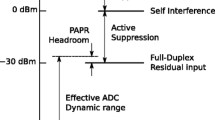Abstract
The effect of amplifier nonlinearity is analyzed for M-QAM full-duplex communications in additive white Gaussian noise channels. Two classical memoryless nonlinear amplifier models, i.e., a traveling-wave tube amplifier and a solid-state power amplifier, are considered. An analytical expression for the bit error ratio is derived using a characteristic function and numerical integration. Theoretical results show perfect agreement with those obtained by simulation. The analytical results could be used to evaluate the degradation in performance of an M-QAM full-duplex system caused by amplifier nonlinearity, and will be helpful in finding the optimal static operating point of an amplifier.
摘要
创新点
本文分析了非线性功放对M-QAM全双工无线通信性能的影响; 采用行波管功放(TWTA)模型和固态功放(SSPA)模型, 并通过特征函数和数值积分的方法求出M-QAM全双工无线通信误码率的表达式, 最终用仿真验证了理论分析的正确性。本文结论可用于估算M-QAM全双工无线通信中非线性功放带来的信噪比损失, 以及为非线性功放选择最佳的静态工作点。
Similar content being viewed by others
References
Ren P Y, Wang Y C, Du Q H. CAD-MAC: a channel-aggregation diversity based MAC protocol for spectrum and energy efficient cognitive ad hoc networks. IEEE J Sel Areas Commun, 2014; 32: 237–250
Wu G, Ren P Y, Du Q H. Recall-based dynamic spectrum auction with the protection of primary users. IEEE J Sel Areas Commun, 2012; 30: 2070–2081
Hong S, Brand J, Jung C, et al. Applications of self-interference cancellation in 5G and beyond. IEEE Commun Mag, 2014; 52: 114–121
Zhang D D, Wang X, Zhang Z S. Key techniques research on full-duplex wireless communications (in Chinese). Sci Sin Inform, 2014; 44: 951–964
Jain M, Choi J I, Kim T, et al. Practical, real-time, full duplex wireless. In: Proceedings of 17th Annual International Conference on Mobile Computing and Networking, Las Vegas, 2011. 301–312
Choi J Y, Hur M S, Suh Y W, et al. Interference cancellation techniques for digital on-channel repeaters in T-DMB system. IEEE Trans Broadcast, 2011; 57: 46–56
Lee Y J, Lee J B, Park S I, et al. Feedback cancellation for T-DMB repeaters based on frequency-domain channel estimation. IEEE Trans Broadcast, 2011; 57: 114–120
Duarte M, Sabharwal A. Full-duplex wireless communications using off-the-shelf radios: feasibility and first results. In: Proceedings of Asilomar Conference on Signals, Systems and Computers, Pacific Grove, 2010. 1558–1562
Duarte M, Sabharwal A, Aggarwal V, et al. Design and characterization of a full-duplex multi-antenna system for WiFi networks. IEEE Trans Veh Technol, 2014; 63: 1160–1177
White C R, Rebeiz G M. Single- and dual-polarized tunable slotring antennas. IEEE Trans Antenn Propag, 2009; 57: 19–26
Elsherbini A, Sarabandi K. Dual-polarized coupled sectorial loop antennas for UWB applications. IEEE Antenn Wirel Propag Lett, 2011; 10: 75–78
Guo Y X, Luk K M. Dual-polarized dielectric resonator antennas. IEEE Trans Antenn Propag, 2003; 51: 1120–1124
Korpi D, Riihonen T, Syrjala V, et al. Full-duplex transceiver system calculations: analysis of ADC and linearity challenges. IEEE Trans Wirel Commun, 2014; 13: 3821–3836
Bharadia D, McMilin E, Katti S. Full duplex radios. In: Proceedings of the ACM SIGCOMM 2013 Conference on SIGCOMM. New York: ACM, 2013. 375–386
Duarte M, Dick C, Sabharwal A. Experiment-driven characterization of full-duplex wireless systems. IEEE Trans Wirel Commun, 2012; 11: 4296–4307
Anttila L, Korpi D, Syrjala V, et al. Cancellation of power amplifier induced nonlinear self-interference in full-duplex transceivers. In: Proceedings of Asilomar Conference on Signals, Systems and Computers, Pacific Grove, 2013
Ahmed E, Eltawil A M, Sabharwal A. Rate gain region and design tradeoffs for full-duplex wireless communications. IEEE Trans Wirel Commun, 2013; 12: 3556–3565
Costa E, Pupolin S. M-QAM-OFDM system performance in the presence of a nonlinear amplifier and phase noise. IEEE Trans Wirel Commun, 2002; 50: 462–472
Proakis J. Digital Communications. 4th ed. New York: McGraw-Hill, 2001. 278–282
Su W M, Gu H, Ni J L, et al. Performance analysis of MVDR algorithm in the presence of amplitude and phase errors. IEEE Antenn Wirel Propag Lett, 2001; 49: 1875–1877
Author information
Authors and Affiliations
Corresponding author
Rights and permissions
About this article
Cite this article
He, Z., Ma, W., Shao, S. et al. Performance of an M-QAM full-duplex wireless system with a nonlinear amplifier. Sci. China Inf. Sci. 59, 102307 (2016). https://doi.org/10.1007/s11432-015-5370-2
Received:
Accepted:
Published:
DOI: https://doi.org/10.1007/s11432-015-5370-2




